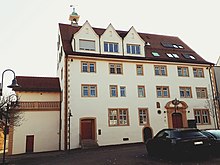Aldingen Castle
Aldingen Castle , also called New Castle or Outer Castle , is a Renaissance- style mansion built in 1580 in Remseck-Aldingen in the Ludwigsburg district in Baden-Württemberg . Together with the Meierhof , the barns, stables and wagon sheds, the castle formed a square courtyard that was only accessible from two gates until 1900.
history
prehistory
The original seat of the Lords of Kaltental , popularly known as Schlössle , was located near the Aldinger Margaretenkirche in the town center. Together with the church, it formed a fortification, but is no longer preserved today. As a result of the Reformation, a Catholic and a Protestant line of the Kaltentaler were formed, which is why the Schlössle became too small as a family seat. Therefore, the outer castle was built by Heinrich von Kaltental on the outskirts of the village as the seat of the evangelical line.
Kaltental residence
The castle was completed in 1580. An inscription plaque above the entrance announces: "Anno Domini 1580 I have Hainrich Von Kaltenthal raise the house Von Grund Uff to build. God B [e] hüts."
From then on, the evangelical line of the Aldinger lords of Kaltental resided here for a good 160 years. The last owner of the house in Kaltental was Georg Wolf von Kaltental. Georg Wolf had been a knight's councilor since 1719 and director of the knight's canton of Kocher , based in Esslingen, from 1731, as well as the Württemberg chief bailiff of Kirchheim , Nürtingen , Denkendorf , Wendlingen , Neidlingen and Owen from 1733 . In order to document his high status in his place of residence as well, he had the simple building fitted out around 1726 or 1728 with a baroque portal with the Kaltental coat of arms and two rooms on the ground floor with rococo stucco and ceiling paintings. The ceiling paintings were created by Paul Ambrosius Reith, who previously also worked on the Knight's Building in Esslingen.
After Georg Wolf died childless in 1746, the Aldinger fiefdom fell back to Württemberg . The Kaltental property in Aldingen, including the castle, was also retained by Württemberg due to its proximity to its Ludwigsburg residence . Georg Wolf's cousins received financial compensation for this in 1750.
Civil use from 1755
In 1755, Württemberg sold the castle again to two citizens of Aldingen. From 1816 there was a brewery in the castle, which was operated by Friedrich Jüngling. Young man's son David Gottlob emigrated to America and founded DG Yuengling & Son there . In 1836 the eastern half of the castle was sold for 2,775 guilders to the municipality of Aldingen, which set up a school with an apartment for the schoolmaster and a room for the council on the second floor. Until 1975 the castle served as the town hall of the municipality of Aldingen and from then until the end of the 20th century as a branch of the Remseck town hall. Today it is privately owned.
There is a restaurant in the former Meierhof.
Individual evidence
- ↑ a b c d City of Remseck: Sights in the Aldingen district (PDF; 806 kB).
- ↑ a b Description of the Oberamt Ludwigsburg. Issued by the Royal Statistical-Topographical Bureau; Unchanged reprint of the edition from 1859, Bissinger, Magstadt 1972, p. 138.
- ^ A b c Norbert Stein, Eduard Theiner, Heinz Pfizenmayer: The Lords of Kaltental and the Reichsfrei Nothaft von Hohenberg . In: Heinz Pfizenmayer (Hrsg.): Local history series of publications of the municipality of Remseck am Neckar . tape 9 , 1989.
- ↑ Dagmar Zimdars (arrangement): Georg Dehio: Handbook of German Art Monuments. Baden-Württemberg I. Deutscher Kunstverlag, Berlin and Munich 1993, ISBN 3-422-03024-7 , p. 8.
Coordinates: 48 ° 51 '48.3 " N , 9 ° 15' 5.2" E


